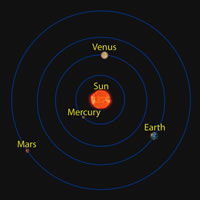Chapter 5
War of the Worldviews
The power of a worldview
A worldview is inescapable. Our worldview consists of our most basic assumptions (presuppositions) about reality. Our most foundational presuppositions (axioms) cannot be proved by something else (otherwise they would not be the most foundational), yet we hold them to be unquestionable. We use these assumptions (often without realizing it) to help us interpret what we observe in the world. We cannot avoid this; without a number of foundational presuppositions about reality we could not make sense of anything. Consider a few assumptions that a typical person might hold to as part of his or her worldview:
- I exist.
- There is a reality beyond myself.
- I have senses which can be used to probe that reality.
- There are laws of logic.
- I can use the laws of logic to draw accurate conclusions about the universe.
Most people would hold to the above assumptions (and many others as well, of course). We cannot actually prove them without making other assumptions, and yet we could not function without them. Suppose I see a small rock on the side of the road and I decide to pick it up. I have assumed quite a lot to take this action. I must have reasoned that (1) I exist—otherwise I couldn’t pick up the rock. I assume that there is a rock—it is part of (2) a reality beyond myself. I have concluded that the image passed on to my brain by my eyes is an accurate representation of that reality (3). I have used logic to draw the conclusion (5) that I can pick up the rock; this means I have also presupposed that there are laws of logic (4). These assumptions are automatic; we don’t even have to think about them. Yet, without them we could not know that it is possible to pick up that rock. These presuppositions (and others) constitute a person’s worldview. Clearly, a worldview is essential in order to know anything about the universe.
How are we to know if we have an accurate worldview? Is there any reason to think that our most basic assumptions about reality are correct? Although most people would agree on the five assumptions listed above, many people disagree on other very foundational ideas. These include: the existence of God, the nature of truth, the origin of the universe, the origin of life, morality, and many others. When people disagree on their most basic assumptions, how do we determine who has the more accurate worldview?
Illumination from the created universe

Greek astronomer Claudius Ptolemy
A person might argue that his or her worldview is accurate because it can explain the scientific evidence, but all worldviews can do that—that’s what they are for.1 External evidence can never prove or disprove a person’s worldview in an absolute sense. The reason is simple: evidence is always interpreted in light of that person’s worldview. The evidence doesn’t “speak for itself”; it’s the interpretation that is significant, and the interpretation is bound to be compatible with the worldview that produced it. This is inevitable.
As an example, consider the disintegration of comets discussed in chapter 3. Recall that comets cannot last for millions of years, and thus their existence supports the biblical age of the solar system. Does this refute the naturalist’s worldview (which holds to an age of the solar system of about 4.5 billion years)? The naturalist says, “Of course not. It simply means that there must be an as-yet-undiscovered Oort cloud (or genuine Kuiper Belt with numerous actual comet-sized objects) which produces new comets to replace the ones that decay.” The naturalist has proposed an additional hypothesis which brings the evidence into line with his worldview. Both creationists and evolutionists can do this with any evidence. Therefore, external evidence contrary to the expectations of a worldview cannot strictly disprove that worldview because one can always add on additional auxiliary (supporting) conjectures to bring the evidence into line.
Let’s look at another example: Centuries ago, there was a commonly held belief called “geocentrism.” This idea holds that the sun and all the planets revolve around the earth. The geocentric model was strongly promoted by the Greek astronomer Ptolemy. Today, we hold to the heliocentric model—the idea that the planets (including Earth) orbit around the sun.2 One might suppose that it would be easy to distinguish between these two models; simply watch how the planets move—examine the evidence.

The helioecentric model of the solar system

The geocentric model of the solar system
The motions of the planets in the night sky are fully compatible with heliocentrism; the planets (and the earth) appear to orbit the sun. Such motions were well known in ancient times, but Ptolemy was able to explain these motions within the geocentric framework by the addition of supplementary assumptions. Ptolemy postulated that each planet orbits in a little circle which in turn orbits a larger circle centered on the earth.3 The little circles are called “epicycles” and the larger circle is the “deferent.” Thus, in Ptolemy’s view, planets orbit the earth in a “spirograph” fashion—making little circles which move along a larger circle.
Amazingly, Ptolemy’s geocentric model of the solar system is able to predict the positions of the planets with a fair degree of accuracy—despite the fact that it is wrong.4 By careful adjustment of the size of the epicycles and the speed at which the planets circumnavigate them, the observations can be explained within a geocentric framework. Of course, the heliocentric model can also accurately predict the positions of planets. Both models can explain the evidence and correctly predict future observations. The main difference is that the heliocentric model is far simpler; it does not require any epicycles at all,5 and this is the lesson. The incorrect model required additional assumptions (epicycles) and adjustments to make it “fit” the facts. The correct model did not.6
Today, there are many similar battles between opposing frameworks of thought. There is creation versus evolution, billions of years versus thousands, naturalism versus supernaturalism, and secular humanism versus Christianity. As with the competing models of the solar system, these battles are not primarily about evidence; rather, they are about how such evidence is interpreted. When it comes to our worldview, do we use the Word of God to interpret evidence, or do we use the opinions of fallible human beings?
A biblical view of the universe
We have seen that when it comes to astronomy, the biblical worldview makes sense of the scientific evidence in a straight-forward way without the need for excessive arbitrary assumptions. In chapter 1, we explored how the vastness and beauty of the universe declare God’s glory. God could have chosen to create only the earth, sun, and moon, and life would have been possible; but instead He chose to make a universe immense beyond imagination to give us just a small taste of His incredible magnificence.
In chapter 2, we saw that the Bible has always been right about astronomy. The sphericity of the earth which hangs on nothing, the expansion of the universe, the countless numbers of stars, the conservation principles of mass and energy, and the ordinances of the universe are all important astronomical concepts that are taught in the Bible. In many cases, the popular secular view of the day contradicted the biblical teachings, but the Bible has been vindicated.
In chapter 3 [part 1, part 2], we saw how the biblical time scale is confirmed by scientific evidence. We understand that these evidences can always be interpreted in light of the secular view by the addition of extra assumptions (an undetected Oort cloud, spiral density waves, magnetic dynamos, etc.). We have also seen that there is no need for these conjectures in the biblical worldview. The Bible provides a logical, self-consistent interpretation of scientific evidence supporting a universe that is thousands of years old. Conversely, the arguments offered in favor of the secular view generally assume uniformitarianism and/or naturalism and are thus circular.
In chapter 4 [part 1, part 2], the secular belief in naturalism was challenged on both philosophical and scientific grounds. Problems with the secular big-bang and solar accretion models such as the missing antimatter, extrasolar planets (hot Jupiters), and star formation are in fact design features for creation—perfectly consistent with the Bible. The biblical implication that the earth is unique and that it alone harbors life is confirmed (so far) by observational astronomy.
We acknowledge that these evidences can be reinterpreted by the addition of untested assumptions. The atheist might assume that the universe really is teeming with life; we just haven’t detected any yet, for whatever reason. The biblical worldview makes sense of the evidence without the need for copious additional conjectures.
Nonetheless, a person who holds dogmatically to the secular worldview will not be convinced by these evidences—nor by any evidences. There is a popular story about a psychologist treating a patient with a bizarre problem; the patient is convinced that he himself is, in fact, dead. The psychologist points out that all the medical evidence points to the fact that the patient is alive, and is in perfect physical health, but the patient remains unconvinced—pointing out that medical evidence can be misinterpreted.

Orion Nebula
Frustrated, the psychologist finally comes up with a plan to prove to his confused patient that he is, in fact, not dead. He asks the patient, “Do dead men bleed?” The patient replies, “No.” At this point, the psychologist pulls out a small pin and pricks the patient’s finger. A small drop of blood appears. “See! You’re bleeding,” says the psychologist, confident at having made his point (literally). The patient replies, “Wow! I guess I was wrong. Looks like dead men really do bleed, after all!”7
This story reinforces a profound truth. When a person is committed to a particular assumption or worldview, no amount of evidence can change his mind, because the evidence can always be explained away by additional assumptions. Much of secular science has become like the “dead” man in the above tale. Secular scientists are well aware of the many problems with the big bang and secular models of solar system formation. Since they are unwilling to abandon the secular worldview, they are forced to create assumption upon assumption in order to explain away evidence—evidence that is perfectly consistent with the biblical worldview. How many supporting assumptions can a worldview take? How many “epicycles” must we add before a person will consider the possibility that it may not be the evidence that is the problem, but the secular worldview?
The biblical worldview
If we build our thinking on the Bible, the inspired Word of the God of the universe, then we have a correct foundation for an accurate worldview. Only the biblical worldview can provide a basis for logical thought and scientific inquiry which is self-consistent, makes sense of the scientific evidence, and provides an absolute moral standard. Notice that the five example assumptions at the start of this chapter are logically consistent with the Bible. I exist (1) because God made me (Psalm 139:14). There is a reality (2) because God created it (Genesis 1:1). God created my senses (Psalm 94:9) so that I might be able to probe and master (Genesis 1:26–28) the reality He created (3). There are laws of logic (4) which we can use (5) (Isaiah 1:18) because these were used by Jesus Christ. (As one example, Jesus used logic in Luke 24:39 when He argues that He cannot be merely a spirit because a spirit does not have flesh and bone which He does have.)
Although the unbeliever suppresses the truth of the Bible, he cannot help but borrow the above biblical principles. He inconsistently uses biblical truths while simultaneously denying the Bible from which these truths are deduced. For example, although there is no basis for believing that the mind can use laws of logic to reason in a naturalistic worldview, the naturalist nonetheless knows that the mind can indeed reason. The Lord has “hardwired” us to be thinking creatures.

The Bug Nebula, NGC 6302
According to the Bible, God made human beings in His own image (Genesis 1:27). As such, we reflect in a finite, limited way some of God’s infinite attributes. God is omniscient; He knows absolutely everything that is true. Thus, we can know some things. God is logical and self-consistent. Thus, we too can use logic and draw consistent conclusions. God has given us the ability to reason—to think some of His own thoughts after Him.
Although we have sinned, and now suffer the effects of the Curse, we still cannot help but know (on some level) that there is a God. His divine attributes are clearly seen in the universe He has made (Romans 1:20). From the beauty of Saturn’s rings to the majestic arms of the most distant spiral galaxies, God’s character is displayed throughout the universe, and there is no excuse for dismissing this fact. The created universe tells us that that there is indeed a Creator God (Psalm 19:1–6) of infinite power and imagination. God’s world confirms what we read in God’s Word.
The history book of the universe
Although the Bible is accurate when it touches upon astronomy (and everything else), its primary purpose is not to be a mere science textbook. The Bible is primarily a history book which shows us our place in God’s universe and how to have a right relationship with Him. It is to be used as a guide—a “lamp” unto our feet (Psalm 119:105) giving us illumination to walk the path (Proverbs 3:6) that God has laid out for us. God loves us and has created us for fellowship with Him. His desire is that we would love Him (Mark 12:30) and enjoy our life in Him (John 10:10).
God has not forced His fellowship on us; He gave mankind the freedom to choose to accept His love, or to reject it. In Adam, the human race chose to rebel against God, and the world was cursed as a result of Adam’s sin. We, like Adam, have all sinned against God (Romans 3:23) in various ways (Romans 5:12–14), and the penalty for such rebellion against God is death (Romans 6:23). We all deserve death and hell because we have sinned against an infinitely holy God, and since God is righteous, He must judge all sin—otherwise there would be no justice.
Since our shortcomings offend His infinite holiness, the punishment must also be infinite. Either we must suffer such punishment, or else a substitute must endure it in our place (Isaiah 53). The substitute must be fully human to substitute for humanity (Hebrews 2:14), and must be our blood relation (through Adam) so he can be our “kinsman redeemer” (Isaiah 59:20, same word in Ruth 2:20). He must be perfectly sinless, too, so He would not have to atone for sins of His own (Hebrews 7:27), and must be fully divine so as to be able to endure God’s infinite wrath (Isaiah 53:10).
Fortunately, God did not leave us without a way back to a right relationship with Him. The second person of the Trinity took on human nature (Philippians 2:5–11), becoming the “last Adam” (1 Corinthians 15:45), a descendant of the first Adam (Luke 3:38). Thus, He satisfies all the requirements for a substitute. Being both God and man, Jesus can also be our mediator (1 Timothy 2:5). Jesus Christ paid the penalty for sin for humanity (1 Peter 3:18) by dying on the Cross. He took our place and died our death. The penalty for sin has been paid, and justice has been satisfied. We can be made right with God through simple faith and trust, via God’s gracious gift, the sacrifice of His son (Romans 6:23). We do this by confessing that Jesus is Lord and by placing our faith in Him (Romans 10:9–10). Through this, our fellowship with God is restored. Even though we will all someday die physically (unless the Lord comes first), the Lord has promised that we will live again (John 11:25) forever in fellowship with Him if we believe on Him, grasping hold of His gift (Romans 6:23). There is no way we could possibly earn this gift of salvation (Ephesians 2:8–9); it is entirely by God’s grace, received by faith.

Some people have the mistaken impression
that God will let them into heaven without
faith in Christ because they are “basically
good.” The Bible makes it clear that no one
is “good” (Romans 3:10; Psalm 14:3) because we
all have sinned (Romans 3:23).8
If God were to
let sin go unpunished, then there would be
no justice. Furthermore, sin ruins paradise.
Remember, it took only one sin (by Adam) to
ruin the perfect world that God had created.
God has said that He will in the future make
a new heavens and a new earth; paradise will
be restored. The new heavens and earth will
remain perfect forever, which means not even
one sin can enter in. Therefore, no one can
enter heaven unless he or she has been the
willing recipient of Christ’s payment for sin.
The Bible says that God is “not willing that
any should perish but that all should come
to repentance
” (2 Peter 3:9). Nevertheless,
some will reject His
gift of grace, but if we
reject God, then we are
rejecting all that God
is—peace, joy, eternal
life. Therefore, we would
be accepting suffering,
hopelessness, a sort of
eternal “death”—in
other words hell. Hell is
eternal existence apart
from God’s fellowship. Such an
existence would necessarily be
hollow, empty, and hopeless,
because we were designed to
be in fellowship with God. In this present
life, our alternatives are either a relationship
with God by receiving Jesus as Lord, or being
separated from God, in effect rejecting
Jesus. At death, God in a sense ratifies our
choice (Hebrews 9:27). The biblical worldview is
therefore much more than just a platform for
scientific research. While it does provide the
foundation for good science, it also provides
the basis for correct thinking about the
Lord, origins, morality, and eternity. Only
the Word of God can provide such a foundation.
When we do science experiments, we do
them in the present, physical universe; such
methods are limited to the natural world.
Based on his own experiences and empirical
data, man can know nothing of the coming
resurrection, or the nature of morality. It is
only by revelation from the Lord (the Bible)
that we can know these things with certainty.
Creation astronomy
It has been said that astronomy is the least well-developed field in creation science. Far fewer creationist books and papers have been written in the field of astronomy than in the fields of biology or geology. This may be in part due to the fact that there are currently so few biblical creationist astronomers when compared to creation scientists in other fields. Yet, we have seen that astronomy strongly confirms what the Bible teaches, and the secular alternatives are inadequate on multiple levels.
Still, there is a lot more to be discovered and there are unanswered questions in the field of creation astronomy.9 When it comes to creation-based models of the universe, I am convinced that we have only scratched the surface. Future discoveries in astronomy will continue to confirm the Bible by exhibiting the power and ingenuity of the Lord in ways that we cannot yet imagine. I am also convinced that much of the astronomical evidence for biblical creation is already known, but has been misinterpreted because of a secular bias.
The quantity of astronomical data available today is staggering. The number of books and technical papers in the field of astrophysics is equally staggering, and yet, the vast majority of these are written from the fallacious worldview of naturalism. This causes the interpretations of the data to be problematic, necessitating the addition of numerous arbitrary “secondary” assumptions. What is needed is to approach this existing information from a biblical framework.
This book is meant to be an introduction only—a starting point to a biblical view of the universe. We have shown how astronomy facts that are well known (recession of the moon, disintegration of comets, extra-solar planets, lack of antimatter, etc.) are strongly consistent with the Bible and problematic for secular scenarios. Many more such explorations are possible. Who knows what amazing truths are waiting to be discovered if only the shackles of secular thinking are removed. Now is the time of discovery. It is time to take back astronomy.
Creation In-depth:
Internal Inconsistencies in Worldviews
Some worldviews cannot be entirely correct because they are internally inconsistent. Consider the beliefs of a materialist. Such a person believes that all things are physical; nothing immaterial exists. The materialist uses reason and the laws of logic to support his beliefs, but he does so inconsistently. In his view, there can be no laws of logic since they do not exist physically. There is no place in the universe where you can “see” the laws of logic; they are intangible and thus cannot exist according to the materialists’ professed beliefs. His reasoning is self-refuting.
Likewise, the evolutionist who believes that all life is merely an accidental by-product of chemicals, mutations, and natural selection has an internal inconsistency. Such a person must (by his own professed beliefs) accept that the human brain has developed accidentally. So why should we trust the brain’s conclusions? We have no reason to accept assumption (5) in the list above if evolution is true. The evolutionist worldview is therefore internally inconsistent. The evolutionist accepts assumption (5) to support his worldview which does not comport with assumption (5).
The evolutionist might respond that natural selection has guided the brain so that it can determine truth. There is no reason to assume that that is true, because it does not logically follow that survival value equates with the ability to determine truth. In fact, some incorrect beliefs might have survival value: for example, the belief that it is morally acceptable to do whatever I want (lie, steal, murder, etc.) as long as it increased my chances of survival.
Inconsistencies of Practice
Many worldviews lead to conclusions which are incompatible with the behavior of the persons who profess them. For example, a naturalist has no basis for an absolute moral standard, and yet most naturalists would nonetheless hold to a moral standard, and would be outraged if someone else were to violate it. If the universe is merely an accident, then what is the basis for right and wrong? What distinguishes a good action from an evil one in the naturalist’s view?
For example, most naturalists would believe that murder is wrong. Why should that be so? By the naturalist’s own assumptions, a human being is merely an accident of the universe. Why should one accident eliminating another be considered wrong? The naturalist can make up an arbitrary standard for morality (perhaps morality is determined by majority opinion, or inborn “feelings”) but has no absolute basis for one. As such, he has no basis for imposing his mere opinions of right and wrong on others. Only a creation-based worldview allows for the existence of absolute morality. If there is a Creator to whom we owe our existence, then that Creator can set the standards. The God of the Bible has created such standards—laws of morality which are absolute.
Taking Back Astronomy
Dr. Lisle communicates the truths of creation and the fallacies of evolution with authority and enthusiasm. In this richly illustrated book, Lisle debunks the most widely accepted teachings about the idea of evolution. Readers are given solid answers to many questions, including the speed of light, the big bang, extraterrestrials, the reliability of the Bible regarding astronomy, and more.
Read Online Buy BookFootnotes
- However, not all worldviews can provide a foundation for science and reason. Is there any reason to believe that the universe would obey orderly principles if it were simply an accident? Science depends on the fact that the universe is orderly and logical and conforms to uniform laws. Such properties are expected within a biblical worldview, since a logical Creator constructed the universe and imposed order on it, but many other worldviews cannot account for these foundational axioms of science.
- To be precise, the planets and sun orbit about their common center of mass. However, since the sun is so massive, the center of mass between the sun and the earth is well inside the sun. Nonetheless, the sun “wobbles” slightly as the planets orbit it. Many extrasolar planets have been discovered by the “wobble” they induce on their star.
- In later geocentric models, the circle’s center is offset slightly from earth.
- Of course, the issue of whether A orbits B or B orbits A is in a sense just a choice of reference frame (allowing “non-inertial” reference frames). However, when a third object is added, the symmetry is broken. Thus, the other planets definitely orbit the sun, not the earth. For example, Venus is sometimes in between the sun and the earth; at other times the sun is in between earth and Venus. This would not be possible in the Ptolemaic system.
- Today, we have many additional evidences that confirm the heliocentric model of the solar system: the phases of Venus, the moons of Jupiter, etc. are all difficult to explain in a geocentric view.
- The heliocentric model has, though, been refined by further adjustments that have improved its accuracy. For example, planetary orbits are better approximated by an ellipse than a circle. The physics of relativity has shown that a precessing ellipse is an even better approximation than an ellipse, and so on, but the basic framework has not changed.
- In fact, blood can be made to ooze for a while from a pierced fresh corpse. We could have said that the pin struck an artery, causing a fine pulsating spray of blood, but presumably most will take this as intended—a parable, not a physiology lesson.
- People who have never heard the gospel are punished because they are sinners, not “because they haven’t heard.” They have the witness of creation (Romans 1:18–28) and their own consciences (Romans 2:14–16), so are “without excuse.”
- There is not yet a consensus on distant starlight—however, big-bangers have a light travel–time problem of their own, and creationists have several possible models. We have yet to see a unified creation-based cosmology which will provide many of the scientific details on the origin and structure of the universe all within a biblical framework. We also need a detailed biblical model of stellar aging—how stars change with time.
Recommended Resources

Answers in Genesis is an apologetics ministry, dedicated to helping Christians defend their faith and proclaim the good news of Jesus Christ.
- Customer Service 800.778.3390
- Available Monday–Friday | 9 AM–5 PM ET
- © 2025 Answers in Genesis




